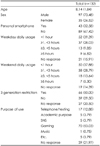Abstract
Objectives
The objective of this study was to assess the characteristics of smartphone use in elementary school children and the emotional and behavioral problems associated with smartphone overuse and addiction.
Methods
Children referred to a community based pediatric mental health center were screened for smartphone addiction and related problematic behavior using the Smartphone Addiction Proneness Scale and the Korean version of the Child Behavior Checklist (CBCL).
Results
1) Statistically significant differences in gender, usage time, ownership, and internalization symptoms (somatization, anxiety/depression, withdrawal) were observed between the smartphone excessive user group and the control group. 2) Variants showing the most significant correlation with smartphone addiction were usage time, internalization problems somatization, anxiety/depression, withdrawal, aggressive behaviors, and total behavior problems.
Figures and Tables
Table 2
Comparison between excessive user group and control group in characteristics of smartphone use

References
1. National Information Society Agency. Internet addiction survey 2012. Seoul: National Information Society Agency;2013.
2. Korea Internet & Security Agency. Survey on smartphone use. Seoul: Korea Internet & Security Agency;2012.
3. Jung H. Smartphone and future use. J Korea Contents Assoc. 2010; 8:28–33.
4. Kang HY, Park CH. Development and validation of the smartphone addiction inventory. Korean J Psychol Gen. 2012; 31:563–580.
5. Ministry of Science, ICT and Future Planning. 2012 survey on internet addiction. Gwacheon: Ministry of Science, ICT and Future Planning;2013.
6. World Health Organization. Expert committee on addiction-producing drugs. Geneva: World Health Organization;1964.
7. American Psychiatric Association. Diagnostic and Statistical Manual of Mental Disorders: DSM-5. Washington, DC: American Psychiatric Association;2013.
8. National Information Society Agency. Development of Korean Smartphone Addiction Proneness Scale For Youth and Adults. Seoul: National Information Society Agency;2011. p. 85–86.
9. Park C, Park YR. The conceptual model on smart phone addiction among early childhood. Int J Soc Sci Humanit. 2014; 4:147–150.

10. Cho SM, Sung MJ, Shin KM, Lim KY, Shin YM. Does psychopathology in childhood predict internet addiction in male adolescents? Child Psychiatry Hum Dev. 2013; 44:549–555.

11. Ha JH, Kim SY, Bae SC, Bae S, Kim H, Sim M, et al. Depression and Internet addiction in adolescents. Psychopathology. 2007; 40:424–430.

12. Lee MJ, Lee JS, Kang MH, Kim CE, Bae JN, Choo JS. Characteristics of cellular phone use and its association with psychological problems among adolescents. J Korean Acad Child Adolesc Psychiatry. 2010; 21:31–36.

13. Yen CF, Tang TC, Yen JY, Lin HC, Huang CF, Liu SC, et al. Symptoms of problematic cellular phone use, functional impairment and its association with depression among adolescents in Southern Taiwan. J Adolesc. 2009; 32:863–873.

14. Shaw M, Black DW. Internet addiction: definition, assessment, epidemiology and clinical management. CNS Drugs. 2008; 22:353–365.
15. OReilly M. Internet addiction: a new disorder enters the medical lexicon. CMAJ. 1996; 154:1882–1883.
16. Achenbach TM, Edelbrock CS. Manual for the child behavior checklist and revised child behavior profile. Burlington CT: Queen City Printers;1983.
17. Oh KJ, Lee HR. Development of Korean version of child behavior checklist (K-CBCL). Seoul: Korean Research Foundation Report;1990.
18. Ko CH, Yen JY, Chen CC, Chen SH, Yen CF. Gender differences and related factors affecting online gaming addiction among Taiwanese adolescents. J Nerv Ment Dis. 2005; 193:273–277.

19. Weiser EB. Gender differences in Internet use patterns and internet application preferences: A two-sample comparison. Cyberpsychol Behav. 2000; 3:167–178.

20. Kim DI, Lee YH, Lee JY, Kim MC, Keum CM, Nam JE. New patterns in media addiction: is smartphone a substitute or a complement to the internet. Korean J Youth Couns. 2012; 20:71–88.

21. Song J, Oh SH, Kim EM, Na EY, Jung HS, Park SR. Media user patterns of adolescents in a multimedia environment: an assessment of gender and income differences. J Commun Res. 2009; 46:33–65.
22. Council on Communications and Media. From the American Academy of Pediatrics: Policy statement--Media violence. Pediatrics. 2009; 124:1495–1503.
23. Ferdinand R, Verhulst F. Psychopathology from adolescence into young adulthood: an 8-year follow-up study. Am J Psychiatry. 1995; 152:1586–1594.
24. Widyanto L, Griffiths M. 'Internet addiction': a critical review. Int J Ment Health Addict. 2006; 4:31–51.

25. Ybarra ML, Alexander C, Mitchell KJ. Depressive symptomatology, youth Internet use, and online interactions: A national survey. J Adolesc Health. 2005; 36:9–18.

26. Griffiths M. Internet addiction: fact or fiction? Psychologist. 1999; 12:246–250.
27. Griffiths M. Internet addiction - time to be taken seriously? Addict Res Theory. 2000; 8:413–418.

28. Yen JY, Yen CF, Chen CS, Tang TC, Ko CH. The association between adult ADHD symptoms and internet addiction among college students: the gender difference. Cyberpsychol Behav. 2009; 12:187–191.





 PDF
PDF ePub
ePub Citation
Citation Print
Print





 XML Download
XML Download